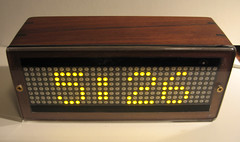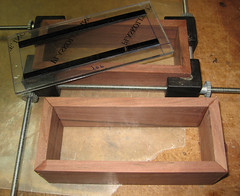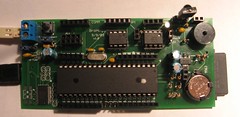 Sounds like something a lawyer would say.
Sounds like something a lawyer would say.Building this case took a solid weekend.
The wood is walnut. I know this wood well because 25 years ago it was a tree on our land in Arkansas. We had to cut down some walnuts to make room for the house and we hauled them to the mill and had them cut into boards. For me, it's a nice mix of the past and present.
I planned a board down to 5/16", cut it up, and mitered the ends. Then I glued up a box.

The board was wide enough to make 2 boxes. I also made the acrylic front using acetone to chemically wield two black strips that hold the 8x32 matrix in place. The IR sensor is glued over a small hole drilled in the top black strip.
I got a few gaps in the wield which show up as shinny spots on the black strips. Next time a little more acetone and better clamping. I used tripoli abrasive on a buffing wheel to finish the edges.
To make the box stronger, and more interesting, I added ebony splines in the corners. I do this with a jig I made for my router table. Its kind of a sled that holds the box at 45° (photo).
After cutting off the excess ebony (photo), I rounded all the corners with the router.
On the inside of the box there's a platform that holds the board in position to line up the SD socket with a slot in the side of the case (photo). I used the router to cut the slot, and a little sanding drum to make the recess in the case for fingers to get at the card (photo).
A back cover of clear acrylic was made to fit into a rabbet cut around the back of the box. A power jack and an RJ14 jack for the PSC05 was added to the back. There's also a hole for the USB cable when I'm developing (photo). (Later I added a wood dowel with a hole that fits over the stem of the reset button to bring it out to the back of the case (photo).
The box was finished with a light coat of tung oil varnish. (photo)
Finally, the obligatory video . . .
